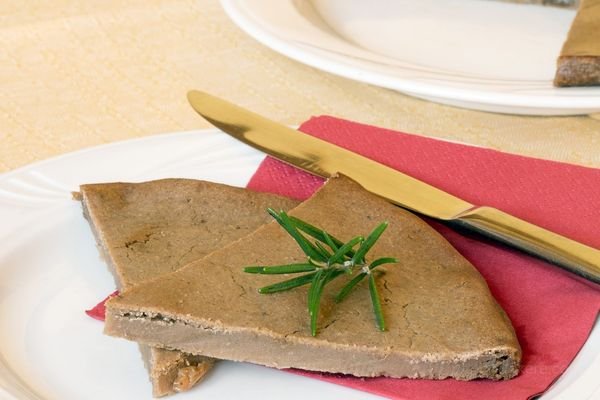Castagnaccio cake, also known as “Torta di Castagne” or “Chestnut Cake,” is a traditional Italian dessert with a fascinating history that dates back centuries.

Origins of Castagnaccio Cake
Historical Background
The history of Castagnaccio cake can be traced back to the regions of Tuscany, Liguria, and Emilia-Romagna in Italy. It originated as a humble peasant dish, where chestnuts were plentiful and commonly used in cooking.
The cake’s creation was born out of necessity, as chestnut flour provided a nutritious and affordable alternative to wheat flour, which was scarce during certain periods.
Regional Variations
Although Castagnaccio cake has its roots in central Italy, variations of this delectable dessert can be found in different regions across the country.
In Tuscany, it is typically prepared with minimal ingredients, focusing on the natural sweetness of chestnut flour. In Liguria, additional ingredients such as pine nuts, rosemary, and raisins are often incorporated, adding complexity to the flavor profile.
Ingredients and Preparation
To create a Castagnaccio cake, the key ingredient is chestnut flour, which imparts a unique nutty flavor and dense texture. Here is a glimpse into the traditional preparation process:
Chestnut Flour
Chestnut flour, made from dried and ground chestnuts, forms the foundation of Castagnaccio cake. This gluten-free flour has been a staple in Italian cuisine for centuries. It is packed with nutrients and adds a distinctive earthiness to the cake.
Additional Ingredients
Alongside chestnut flour, Castagnaccio cake typically includes olive oil, water, and a touch of salt. Some regional variations incorporate ingredients like pine nuts, rosemary, raisins, or even orange zest to enhance the flavor profile further.
Making the Batter
To prepare the batter, chestnut flour is combined with water, olive oil, and a pinch of salt. The mixture is whisked until smooth, creating a thick, pancake-like consistency. The batter is then poured into a greased baking pan and baked to perfection.
Traditional Serving and Pairings
Toppings and Accompaniments
Castagnaccio cake is often served plain or garnished with a sprinkle of rosemary leaves, pine nuts, and a drizzle of extra virgin olive oil.
The simplicity of the toppings allows the unique flavors of the chestnut flour to shine through. The aromatic rosemary and crunchy pine nuts complement the cake’s dense texture, creating a delightful balance of flavors.
Seasonal Variations
In some regions, Castagnaccio cake is enjoyed during specific seasons, particularly in the autumn when chestnuts are harvested.
During this time, it is common to find variations of the cake incorporating seasonal ingredients such as figs, walnuts, or even a hint of cinnamon.
These additions add a touch of warmth and depth to the cake, making it even more enticing during the cooler months.
Cultural Significance and Festivals
Festivals Celebrating Castagnaccio
Castagnaccio cake holds a special place in Italian culture, with various festivals dedicated to celebrating its deliciousness. In regions like Tuscany and Liguria, these festivals take place during the autumn harvest season when chestnuts are at their prime.
These events offer an opportunity for locals and visitors alike to savor different versions of Castagnaccio, enjoy traditional music and dances, and immerse themselves in the rich cultural heritage surrounding this beloved dessert.
Symbolism and Traditions
Beyond its culinary delights, Castagnaccio cake also carries symbolic meaning. In some regions, it is considered a symbol of abundance and prosperity, as chestnuts were historically an important food source for the local communities.
The act of preparing and sharing Castagnaccio during festive gatherings is seen as a way to honor tradition, connect with one’s roots, and strengthen bonds with family and friends.
Evolution and Modern Adaptations
Contemporary Variations
While staying true to its traditional roots, Castagnaccio cake has also evolved to cater to modern tastes and preferences.
Creative chefs and home cooks have experimented with the original recipe, incorporating different ingredients and techniques to give the cake a contemporary twist.
Variations with chocolate, caramel, or even a hint of espresso have emerged, appealing to those seeking a more indulgent flavor experience.
Fusion with Other Cuisines
Castagnaccio cake has also found its way into the fusion food scene, blending with other culinary traditions to create unique dessert combinations.
Chefs have explored pairing Castagnaccio with ingredients such as mascarpone cream, citrus fruits, or even exotic spices, resulting in innovative desserts that fuse Italian traditions with global influences.
Health Benefits and Nutritional Value
Nutritional Profile of Chestnut Flour
One of the significant advantages of Castagnaccio cake lies in the nutritional benefits of its main ingredient, chestnut flour. Chestnuts are low in fat and high in fiber, making them a healthier alternative to wheat flour-based desserts.
Chestnut flour is also a good source of vitamins, minerals, and antioxidants, contributing to overall well-being.
Potential Health Benefits
Consuming Castagnaccio cake made with chestnut flour can offer several potential health benefits.
The cake’s high fiber content promotes healthy digestion, while the absence of gluten makes it suitable for individuals with gluten sensitivities or celiac disease.
Additionally, chestnuts are known for their antioxidant properties, which may help reduce inflammation and support heart health.
Conclusion
In conclusion, the history of Castagnaccio cake is deeply rooted in Italian culinary traditions. From its humble origins as a peasant dish to its modern-day variations, this delightful dessert continues to captivate food enthusiasts around the world.
Whether enjoyed during festive celebrations or as a comforting treat on a cozy evening, Castagnaccio Whether enjoyed during festive celebrations or as a comforting treat on a cozy evening, Castagnaccio cake provides a delightful combination of flavors and textures. Its rich history, cultural significance, and versatility make it a beloved dessert in Italian cuisine.
